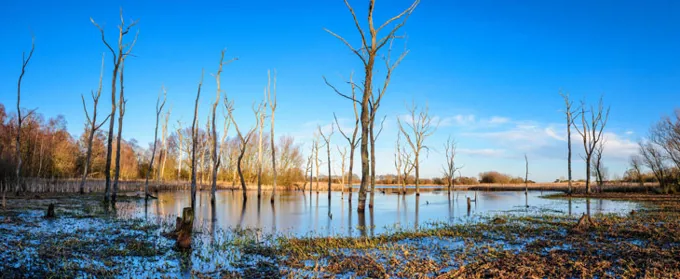
How VA Riparian Property Owners Are Threatened by Rising Sea Levels
“[S]ince the mid-1800s, over 150 square miles of Virginia forests have been converted to marshland and the rate of deforestation today is twice what it was 150 years ago . . . [R]ising water reduces property values . . . .”
Rising Water Creates “Ghost Forests”
Recently, Nature Climate Change published a review study led by a professor from the Virginia Institute of Marine Science (”VIMS”). The study summarizes a number of other studies that have been done on the issue of land conversion caused by sea-level rise. As salt water moves further inland, it creates “ghost forests” by killing off the trees and creating new marshland. According to the VIMS study, since the mid-1800s, over 150 square miles of Virginia forests have been converted to marshland and the rate of deforestation today is twice what it was 150 years ago. It should go without saying that rising water reduces property values, which in turn affects property tax yields, particularly in rural areas.
Rising Water Hurts Farmers in Particular
The VIMS study echoes the experiences of farmers on the Eastern Shore as recently reported in the Bay Journal. There, the rising sea-level is pushing saltwater into the groundwater of some farmland and creating huge areas of high salinity that can no longer be farmed. This problem is exacerbated by the increase in exceptionally high tides, or “sunny day flooding,” which are moving further and further inland and reducing additional farmable areas. The reduction in productive farmland is driving some farmers out of business and is having the wider result of reducing the volume of drinking water available to citizens of the Eastern Shore. As if this were not enough of a problem, this saltwater is leaching nitrogen and phosphorus out of the soil and returning it to the waterways where it is “fuel[ing] algae blooms and trigger[ing] a cascade of harmful ecological events.”
Virginia Government’s Feckless Response
“Until the Commonwealth provides resources to support the program there is little chance that it will accomplish much.”
These are not new issues, but the VIMS study reinforces the point that rising sea-levels affect us all and that we need to continue to encourage our local, state and federal governments to address these issues. Last November, I wrote in this blog about Virginia’s unfunded response to the problem. Until the Commonwealth provides resources to support the program there is little chance that it will accomplish much. With absent leadership at the state level there are a few Virginia localities that are creating coastal resiliency programs of their own. The City of Norfolk, for example, is building one of the more forward leaning resilience programs to be found in the Commonwealth. A good next step for Virginia would be to follow the example of Maryland, which earlier this year passed legislation requiring the state administration to develop a plan to the handle the increased risks from saltwater intrusion and for local governments to address nuisance flooding.
